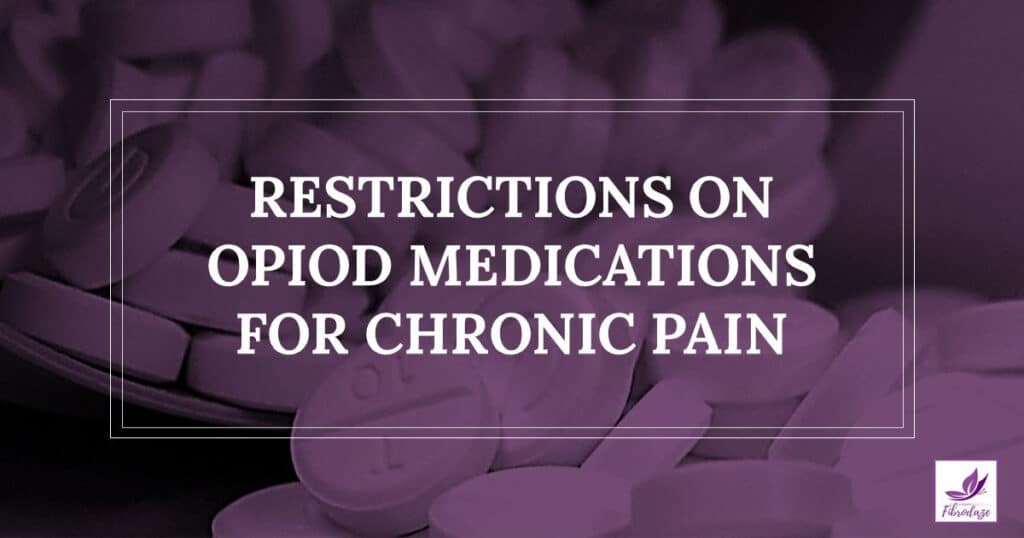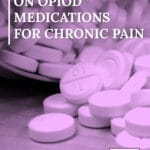For many people living with chronic pain, opioid medications are a critical component to managing their pain and overall quality of life. However, the nationwide crackdown on opioids has put chronic pain sufferers in an impossible situation.

The growing fear and stigma linked to opioid use have led to chronic pain patients being viewed as drug seekers and liars. We are viewed this way whether we take pain medications or not.
In an effort to curb opioid drug abuse and addiction, the Drug Enforcement Administration (DEA) relabeled pain medications as Schedule II drugs. Then the Centers for Disease Control and Prevention (CDC) set new guidelines for physicians on prescribing medications for chronic pain.
The guidelines are advisory, not mandatory, but are likely to be a powerful influence on physicians, insurers, and other government agencies.
State and federal officials are increasingly watching physicians who prescribe narcotics. Some doctors now refuse to prescribe opioid pain medications at all, the doctors that do require you to sign a pain contract.
Pain treatment contracts typically include surprise pill counts, random drug tests, forbid the use of alcohol or illegal drugs, and you must keep your appointments.
Any violation of the agreement and you may be discharged from the doctor’s care and denied further treatment. You can sign one of these contracts, take narcotics long enough to develop physical dependency and be abruptly cut off your pain medication, and left going into withdrawal and feeling extremely ill.
This is so wrong and yet it is happening again and again.
There is no denying there is an opiate addiction problem in this country.
I know at least 4 people who have overdosed on opiates. My own son was addicted to Oxycontin. He got it from a friend which led to him buying it from dealers. After losing his job because of his addiction he started using heroin because it was cheaper and more available. My son beat his addiction over 5 years ago but it was by no means easy.
Opioid Addiction 2016 Facts and Figures from the American Society of Addiction Medicine:
- Drug overdose is the leading cause of accidental death in the US, with 47,055 lethal drug overdoses in 2014. Opioid addiction is driving this epidemic, with 18,893 overdose deaths related to prescription pain relievers, and 10,574 overdose deaths related to heroin in 2014
- The overdose death rate in 2008 was nearly four times the 1999 rate; sales of prescription pain relievers in 2010 were four times those in 1999.
- In 2012, 259 million prescriptions were written for opioids, which is more than enough to give every American adult their own bottle of pills.
- Four in five new heroin users started out misusing prescription painkillers.
- 94% of respondents in a 2014 survey of people in treatment for opioid addiction said they chose to use heroin because prescription opioids were “far more expensive and harder to obtain.
The CDC claims that at least half of all opioid overdose deaths involve a prescription opioid. Yet data collected by the Substance Abuse and Mental Health Service Administration (SAMHSA) shows that the vast majority of opioid addiction starts on the street, not in the doctor’s office.
Addiction in pain patients is rare and occurs in less than 4% of patients treated with opioids. A review of 17 studies involving 88,235 patients with acute and chronic pain, the majority of whom were prescribed opioids for chronic noncancer pain, concluded that opioid use for chronic pain conditions is not associated with a major risk of developing a dependence. The patients who developed problems with opioid use had a prior history of substance abuse.
HealthRising.org published an article about a survey The National Pain Report recently released examining treatment effectiveness. According to the survey, opioids were far more effective for FM patients than the FDA approved fibromyalgia drugs. There were fewer side effects with opioids than the FDA approved drugs as well, and that FM patients were using them responsibly.
The difference between opioid addiction and physical dependence
Addiction is characterized by uncontrollable cravings, the inability to control drug use, and continuing use despite doing harm to oneself or others. Addiction is often called dependence which leads to confusion.
The physical dependence on opioids is normal and can occur without addiction. Physical dependence is the body’s adaptation to a particular drug. The body gets used to receiving regular doses of a certain medication. When the medication is abruptly stopped or the dosage is reduced too quickly, the person will experience withdrawal symptoms.
Opioid withdrawal is generally not dangerous. However, opioid withdrawal is very uncomfortable and distressing. If you find yourself cut off of your pain medications, this article goes through the common symptoms of opiate withdrawal and suggests home remedies and natural treatments to help with each one.
Physical dependence and withdrawal symptoms occur with many medications, not just opioids.
Conclusion
The government’s war on opioids reinforces common misconceptions held by the general public about pain medication use and tends to create the impression that people who use pain medication are addicts -or mere steps away from full-blown addiction.
While controlling the abuse of opioids is necessary, the importance of decreasing drug abuse does not outweigh the needs of millions of people who suffer from chronic pain. Denying access to medication and treating chronic pain patients like criminals will not solve the problem. Ironically, there is evidence that restricting patient access to pain medicine could actually lead to more overdoses, not fewer.
I am allergic to opioids so I was prescribed Tramadol. But since tramadol has been reclassified as a controlled substance I can’t even get that anymore. What struggles are you facing trying to receive treatment for pain?
Pin for Later

Photo Credits: By Adam from UK [CC BY 2.0], via Wikimedia Commons.





I take Tramadol for fibro pain and have for years, no problem getting it. I do know if I miss a dose it isn’t pleasant! Does it depend on your doctor?
Hi, Sandra. It probably does depend on your doctor somewhat. I saw my original doctor for over 10 years (the one who prescribed tramadol) but then she left the area. The next doctor I saw walked in the room and announced that people with fibromyalgia are always looking for their narcotics and that she did not prescribe narcotics. Needless to say, I only saw her once. The doctor I have now is great but she sends me to physical therapy whenever I complain too much about the pain.
I find it disgusting and absolutely cruel , to deny pain medication to those that need it. It should be up to the doctor and no one else to determine the best course of treatment without fear of losing their license or end up in jail. The DEA hasn’t the medical knowledge, to know about what medicine a patient needs. By rescheduling pain medication, it doesn’t stop the recreational user from buying off the street. It only hurts those in pain. I have even read stories of pharmacists commenting the doctor should not be prescribing certain medicine, to the point of calling the doctor and asking if something different should be prescribed. Now, a lot of pharmacies are refusing to fill prescriptions leaving the patient without options. Addicts and patients are not the same thing and should not be lumped together.
I have even read comments from people who were cutoff without notice that the thought of suicide had crossed their minds, as they can’t bear to live in such pain and that’s a damn shame!
I still remember after my car accident in 2001 being without insurance and the free government hospital refusing to give me anything other than Tramadol and cyclobenzaprine, even though I had my x-rays, MRI’S, medical records and list of medications I had used when I was seeing a doctor until the insurance money ran out. I told them that neither of them worked and told them which were effective. They still refused, so I stopped going there as I thought it was pointless. I just wanted to be able to go back to work and have some quality of life. I ended up so bad that I finally had to file for disability. I would think working and contributing was the better option. Guess I was wrong.
I agree wholeheartedly! I received an email from someone who got cut off through no fault of her own. She was going through terrible withdrawals and thought her family would be better off without her. To cut off a pain patient like that is the real crime. These new regulations are not going to keep opioids off the street. Drug dealers are making their own synthetic opioids -one was shut down in my neighborhood a few months ago- which is even more dangerous.
No matter how many letters about the restrictions placed on the opiates, comments, questioning decisions, even asking for mercy, absolutely no response from any! I do not understand why the powers that be have not considered the chronic pain syndrome patient in the beginning. I read the CDC report, and really nothing was mentioned about the chronic pain patient. In fact, when developing this guide line, the pain doctors, patients, and any other professionals that deal with us were not asked for their opinion which I find very disturbing. One doctor who helped develop the guidelines said that the bad outweighs the good when it comes to the opiates. I find that appalling as this is his opinion. It’s not mine nor my doctors. I accept the side affects from the oxycodone as the good out weighs the bad for me! It’s as though there is some sort of agenda going on. For me, I’ve tried everything yet the best is the oxycodone as it actually dulls down the pain. Medical Marijuana has helped, but not as much. I feel it depends upon the severity of the fibro plus other painful illnesses/diseases we may have. I would love to exercise, but I can only do it for a few minutes until the pain becomes unbearable. I do not know how we can get these people to be made aware of the fact that by taking away the opiates from us, some may go to illegal sources to get this much needed medication, others have either thought of or actually have committed suicide. It’s a very sad situation that the CDC and DEA placed us in. We are now considered drug addicts, and the pain clinics treat us that way. To cut our meds back by half is unrealistic for many including me. If they did cut me back by half, I wouldn’t accept it as it accomplished nothing beyond additional pain. Pain that I cannot nor will not live with!
I am very sad to say that 4 percent is an extremly low estimate of how many opiod addictions start in the doctors office. I have seen teenagers given Opana for a broken leg and ohers relapse after dentists perscribe opioids after surgery. My younger sister (47) has been on high does of pain killoers including morphine,oxy and fentanal for a condition doctors say has no cure and is so paqinful that sufferers are known to kill themselves.Unfortunatly the opiods have totally rfoltted her teeth out,make her like a zombie and dont take away all the pain. It is heartbreaking.She is now caught in this opiod restriction.She is on less than half the meds.She is crying in pain all night and my mother just cries and cries. She has tried surgeries and all different treatments.What has happened to her is a tragedy. Alot of these doctors are pill pushers and now when shes in agony every night,do you think he cares less? I wonder if her dosage wasn’t so insanely high if it wouldn’t be so much more painful now that shes been abruptly cut off.
Hi, Holly. I am so sorry to hear about your sister. It is appalling that chronic pain patients are being blamed for a problem we didn’t create. It is criminal that most are being abruptly cut off pain medications and left to go through withdrawal on their own. Your sister will need a good support system to get through this and so will your mother. You will all be in my prayers.
Just in case no one has researched addiction, it isn’t opiods, that’s just hillbilly heroin, it addiction. Maybe that should be explained. Thousands of years ago, in a far away land called Egypt. ….?…
I have fibromyalgia and ever since my Dr up and moved away to different state with no notice just a canceled appointment and letter in the mail saying he was gone, finding a new doctor that will prescribe my medicine was like hell. I had to find someone that took my health insurance that would prescribe my medicine because most of them said if I took a controlled substance for chronic pain they wouldn’t even see me. The doctor that finally agreed to see me screened me before accepting me as a patient and he cut my medicine dosage in half. I take Lyrica and Tramadol. I know compared to some others the medicine I take is nothing and I don’t want to take a higher dosage or stronger drug as long as this works for me and I’m taking the lowest dosage of both of these drugs now. I’ve had some irritability and sweating as my body gets used to the lower dosages but I feel bad emotionally. Not because of the drugs but because of the the way I’ve been treated. I feel like a criminal and I work in the medical field and I’m terrified that they’re going to put on my chart or in their notes at the pharmacy that I’m a drug seeker. I feel like a criminal or like I’m doing something wrong and it’s not right.
Hi, Stacie. No, it’s not right. I have been made to feel like a drug seeker and I am allergic to codeine. Chronic pain patients are lumped together with heroin users. It’s ridiculous!
With the new “guidelines”, I will need to reduce my pain meds to 200 morphine mili-equivalents by January of 2020. My pain specialist will reduce my meds late this year. Luckily, I am currently on 210 morphine mili-equivalents, so its not a drastic reduction.
The problem is, my pain level has been increasing, and my opioids that give me better quality of life, is reducing. It’s so frustrating.
I did find out something interesting during my last appointment. I mentioned an article I read recently about a statement the CDC gave. They reiterated the fact that these are guidelines only, not mandates, and that it was never their intention to take relief away from chronic pain patients. My doctor said that they always knew they were guidelines only. The problem however, lies with the insurance companies. Most of them are unwilling to cover opioids unless they are at, or below the guideline limits. In other words, if I am willing to self pay my opioids, I will not have to reduce. Insurance companies never want to pay for anything anyway. They are a necessary evil for most people though, unfortunately.
I am planning to start a low carb diet soon to lose weight, which is also apparently, anti-inflammatory. I’m really hoping that this diet, along with the weight loss, will reduce the amount of pain that I’m in. Then, maybe I can even reduce the amount of opioids I’m on. One can always hope.
This is exactly what’s wrong with having a for-profit medical system. Insurance companies have too much control over the healthcare we receive. I lost weight when I started following an anti-inflammatory diet several years ago. The weight has stayed off, too. Good luck!